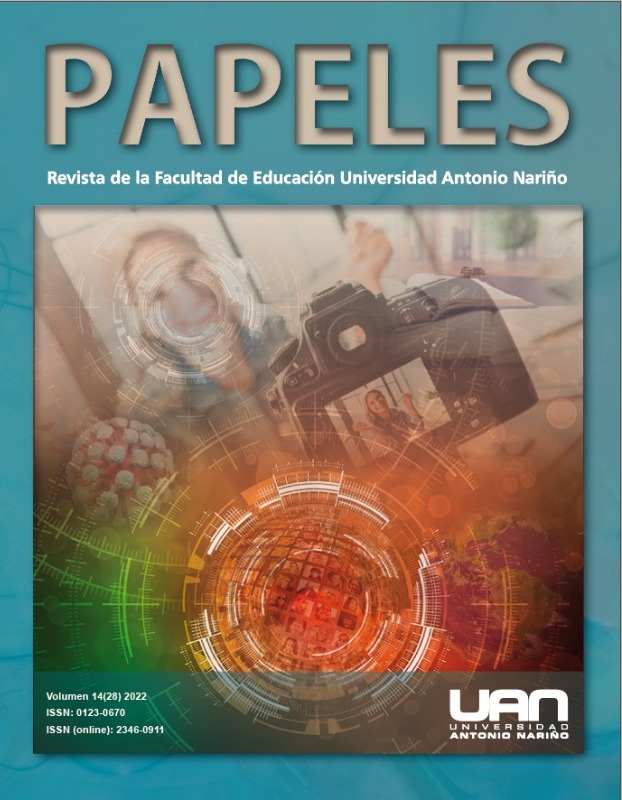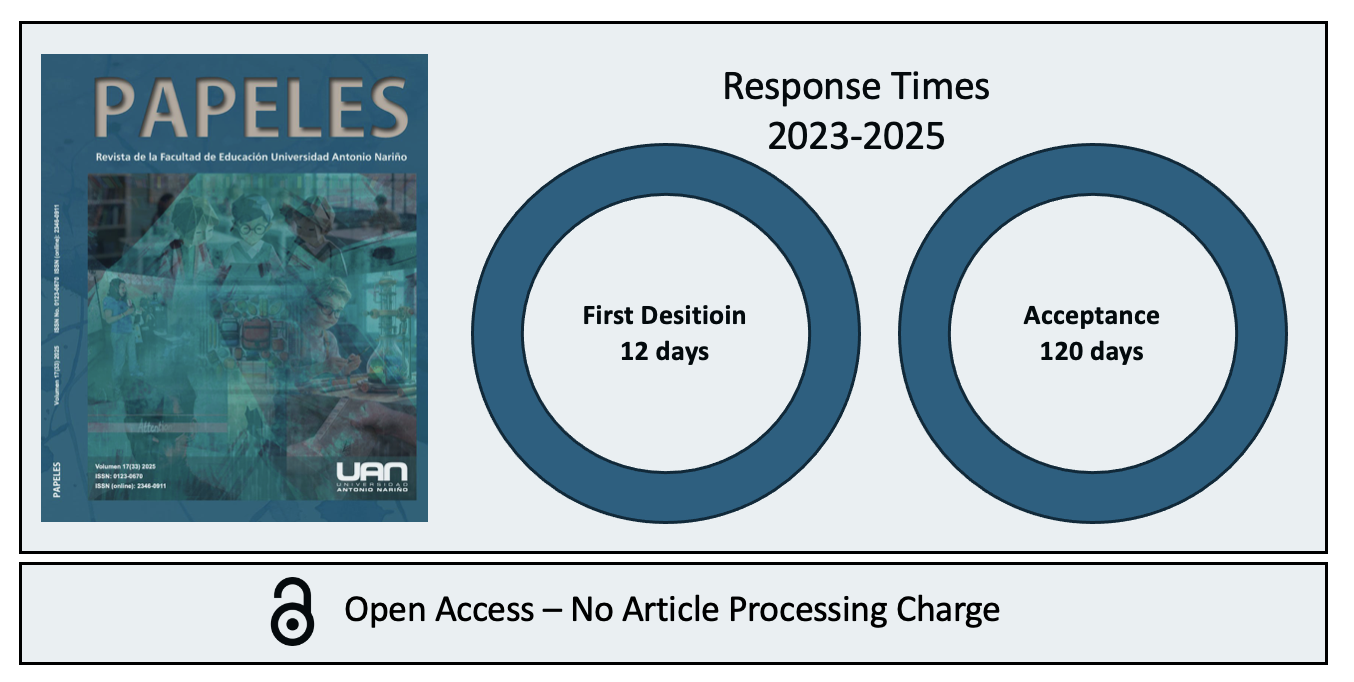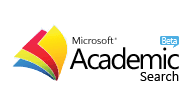Teaching of the Nervous System and Perceptions of Neuromyths in Teachers
Enseñanza del sistema nervioso y percepciones de los neuromitos en el profesorado
DOI:
https://doi.org/10.54104/papeles.v14n28.1272Keywords:
education, teacher training, instruction, neurology, nervous systemAbstract
Introduction: The lack of articulation of neurosciences to educational processes gave rise to a series of misconceptions known as Neuromyths, these fallacies can be assumed by critical formal ignorance of the way the nervous system works. This text intends to describe in the first place aspects of the teaching of the human nervous system and the perceptions about the neuromyths that Natural Sciences teachers have in basic education. Methodology: for this, an online survey was applied to 20 Natural Sciences teachers who work in Basic Education in the Colombian context. Results and discussion: It was found that most teachers address the contents of the nervous system from the exploration of previous knowledge to the development of complex processes of anatomy and physiology. On the other hand, although most teachers do not agree with the neuromyths raised, they still persist: critical periods, hemispheric dominance and the use of 10 % of the brain. In this sense, it is recognized that the prevalence of neuromyths in teachers can have repercussions on educational processes and evidences the gap that still exists between neuroscience and education. Conclusions: According to the above, it is necessary that teacher training programs and educational institutions open spaces for critical reflection that allow teachers and teaching directors to access information related to scientific and technological advances between neuroscience and education.
Downloads
References
Alferink, L. A. & Farmer-Dougan, V. (2010). Brain-(not) based education: Dangers of misunderstanding and misapplication of neuroscience research. Exceptionality, 18(1), 42-52. . https://doi.org/10.1080/09362830903462573
Altman, J. & Das, G. D. (1965). Autoradiographic and histological evidence of postnatal hippocampal neurogenesis in rats. Journal of Comparative Neurology, 124(3), 319-335. https://doi.org/10.1002/cne.901240303
Amran, M. S., Rahman, S., Surat, S. & Bakar, A. Y. A. (2019). Connecting neuroscience and education: Insight from neuroscience findings for better instructional learning. Journal for the Education of Gifted Young Scientists, 7(2), 341-352. https://doi.org/10.17478/jegys.559933
Barraza, P. y Leiva, I. (2018). Neuromitos en educación: Prevalencia en docentes chilenos y el rol de los medios de difusión. Paideia, 63, 17-40. http://revistas.udec.cl/index.php/paideia/article/view/1166/1832
Barrios-Tao, H. (2016). Neurociencias, educación y entorno sociocultural. Educación y Educadores, 19(3), 395-415. https://doi.org/10.5294/edu.2016.19.3.5
Bautista, J. y Navarro, J. R. (2011). Neuronas espejo y el aprendizaje en anestesia. Revista de la Facultad de Medicina, 59(4), 339-351. http://www.scielo.org.co/pdf/rfmun/v59n4/v59n4a06.pdf
Beaty, R. E., Benedek, M., Silvia, P. J. & Schacter, D. L. (2016). Creative cognition and brain network dynamics. Trends in Cognitive Sciences, 20(2), 87-95. doi:10.1016/j.tics.2015.10.004
Beyerstein, B. L. (1999). Whence cometh the myth that we only use ten percent of our brains. Mind Myths: Exploring Popular Assumptions about the Mind and Brain, 2, 314-335.
Bueno i Torrens, D. y Forés i Miravalles, A. (2018). 5 principios de la neuroeducación que la familia debería saber y poner en práctica. Revista Iberoamericana de Educación, 78(1), 13-25. https://doi.org/10.35362/rie7813255
Bullón Gallego, I. (2018). La neurociencia en el ámbito educativo. Revista Internacional de Apoyo a la Inclusión, Logopedia, Sociedad y Multiculturalidad, 3(1), 118-135. https://revistaselectronicas.ujaen.es/index.php/riai/article/view/4251/3476
Burgos Zambrano, D. y Cabrera Ávila, C. (2021). Las neuronas espejo y su incidencia en el aprendizaje. Res non Verba: Revista Científica, 11(1), 54-72. https://doi.org/10.21855/resnonverba.v11i1.443
Cárdenas-Navas, A. M. y Martínez-Rivera, C. A. (2021). Contenidos escolares en ciencias naturales desde el currículo oficial de Colombia. Revista Científica, 42(3), 328-338. https://doi.org/10.14483/23448350.17614
Creswell, J. W. (2009). Research design: Qualitative, quantitative, and mixed methods approaches. Sage.
De Bruyckere, P., Kirschner, P. A. & Hulshof, C. D. (2015). Urban myths about learning and education. Academic Press.
De Smedt, B. (2018). Applications of cognitive neuroscience in educational research. En Oxford Research Encyclopedia of Education. https://doi.org/10.1093/acrefore/9780190264093.013.69
Dekker, S., Lee, P., Howard-Jones & Jolles, J. (2012). Neuromyths in education: Prevalence and predictors of misconceptions among teachers. Frontiers in Psychology, 3(429), 1-8. https://doi.org/10.3389/fpsyg.2012.00429
Del Pozo, M. (2001). Lo que saben y lo que pretenden enseñar los futuros profesores sobre el cambio químico. Enseñanza de las Ciencias, 19(2), 199-215. https://ddd.uab.cat/pub/edlc/02124521v19n2/02124521v19n2p199.pdf
Deligiannidi, K. & P. Howard-Jones, P. (2015). The neuroscience literacy of teachers in Greece. Procedia-Social and Behavioral Sciences, 174, 3909-3915. https://doi.org/10.1016/j.sbspro.2015.01.1133
Denzin, N. & Lincoln, Y. (1994). Handbook of qualitative research. Sage.
Dikmenli, M., Çardak, O. & Öztaş, F. (2009). Conceptual problems in biology-related topics in primary science and technology textbooks in Turkey. International Journal of Environmental & Science Education, 4, 429-440. https://files.eric.ed.gov/fulltext/EJ884407.pdf
Ferrero, M., Garaizar, P. & Vadillo, M. A. (2016). Neuromyths in education: Prevalence among spanish teachers and an exploration of cross-cultural variation. Frontiers in Human Neuroscience, 10, 496. https://doi.org/10.3389/fnhum.2016.00496
Forés, A. (2018). Neuroeducación en las aulas: Cómo despertar la emoción por aprender. Educación 3.0. https://www.educaciontrespuntocero.com/noticias/la-neuroeducacion-llega-a-las-aulas/
Forés, A., Gamo, J. R., Guillén, J. C., Hernández, T., Ligioiz, M., Pardo, F. & Trinidad, C. (2015) Neuromitos en educación: El aprendizaje desde la neurociencia. Plataforma Editorial.
Gómez Galindo, A. A. (2014). Progresión del aprendizaje basado en modelos: La enseñanza del aprendizaje del sistema nervioso. Bio-grafía, 7(13), 101-107. https://doi.org/10.17227/20271034.vol.7num.13bio-grafia101.107
Gago Galvagno, L. y Elgier, Á. M. (2018). Trazando puentes entre las neurociencias y la educación: Aportes, límites y caminos futuros en el campo educativo. Psicogente, 21(40), 476-494. https://doi.org/10.17081/psico.21.40.3087
García García, E., González Marqués, J. y Maestú Unturbe, F. (2011). Neuronas espejo y teoría de la mente en la explicación de la empatía. Ansiedad y Estrés, 17(2-3). 265-279. https://eprints.ucm.es/id/eprint/16341/
Gleichgerrcht, E., Lira Luttges, B., Salvarezza, F. & Campos, A. L. (2015). Educational neuromyths among teachers in Latin America. Mind, Brain, and Education, 9(3), 170-178. https://doi.org/10.1111/mbe.12086
Hernández Sampieri, R. y Medoza Torres, C. P. (2018). Metodología de la investigación: Las rutas cuantitativa, cualitativa y mixta. McGraw Hill.
Higbee, K. L. & Clay, S. L. (1998). College students’ beliefs in the ten-percent myth. The Journal of psychology, 132(5), 469-476. https://doi.org/10.1080/00223989809599280
Hoces, R. y Yus, R. (1995). Las relaciones y la salud mental en las personas. En Ciencias de la naturaleza (vol. 2, pp. 273-437). Edelvives-MEC.
Horta Rivero, E. M., Jiménez de Castro, P. D., Figueredo Tirado, C. M. y Llanes Mesa, L. (2019). Plasticidad neuronal: Un reto para las Neurociencias. Progaleno, 2(2), 110-123. http://revprogaleno.sld.cu/index.php/progaleno/article/view/70/39
Howard‐Jones, P. A. (2011). A multiperspective approach to neuroeducational research. Educational Philosophy and Theory, 43(1), 24-30. https://doi.org/10.1111/j.1469-5812.2010.00703.x
Howard-Jones, P. A. (2014). Neuroscience and education: Myths and messages. Nature Reviews Neuroscience, 15(12), 817-824. https://doi.org/10.1038/nrn3817
Jarrett, C. (2014). Great myths of the brain. John Wiley & Sons.
Jiménez-Pérez, E. H. y Calzadilla-Pérez, O. O. (2021). Prevalencia de neuromitos en docentes de la Universidad de Cienfuegos. Ciencias Psicológicas, 15(1), 1-12. https://doi.org/10.22235/cp.v15i1.2358
Jiménez-Pérez, E. H., López-Rodríguez del Rey, M. M. y Herrera-González, D. (2019). La neurociencia en la formación inicial de docentes. Conrado, 15(67), 241-249. http://scielo.sld.cu/pdf/rc/v15n67/1990-8644-rc-15-67-241.pdf
Jiménez Valladares, J. de D., Hoces Prieto, R. y Perales Palacios, F. J. (1997). Análisis de los modelos y los grafismos utilizados en los libros de texto. Revista Alambique, 11, 75-85.
Karakus, O., Howard-Jones, P. A. & Jay, T. (2015). Primary and secondary school teachers’ knowledge and misconceptions about the brain in Turkey. Procedia-Social and Behavioral Sciences, 174, 1933-1940. . https://doi.org/10.1016/j.sbspro.2015.01.858
Knoll, A. R., Otani, H., Skeel, R. L. & Van Horn, K. R. (2017). Learning style, judgements of learning, and learning of verbal and visual information. British Journal of Psychology, 108(3), 544-563. https://doi.org/10.1111/bjop.12214
Kober, H., Barrett, L. F., Joseph, J., Bliss-Moreau, E., Lindquist, K. & Wager, T. D. (2008). Functional grouping and cortical-subcortical interactions in emotion: A meta-analysis of neuroimaging studies. Neuroimage, 42(2), 998-1031. https://doi.org/10.1016/j.neuroimage.2008.03.059
Koizumi, H. (2003). Science of learning and education: An approach with brain-function imaging. No To Hattatsu, 35(2), 126-129. https://pubmed.ncbi.nlm.nih.gov/12661094/
López Mayorga, Á. y Vargas Jaramillo, J. D. (2021). Neurociencia educativa: Aportes aplicados a la educación formal [trabajo de especialización]. https://repositorio.unbosque.edu.co/handle/20.500.12495/7435
Martínez-Marcos, A., Trejo, J. L. & López-Mascaraque, L. (2016). 50th Anniversary of Adult Neurogenesis: Olfaction, hippocampus, and beyond. Frontiers in Neuroscience, 10, 319. https://doi.org/10.3389/fnins.2016.00319
Melero Carrasco, H. (2015). Sinestesia, bases neuroanatómicas y cognitivas [tesis doctoral, Universidad Complutense de Madrid]. https://eprints.ucm.es/id/eprint/30996/
Meneses Granados, N. (2019). Neuroeducación: Solo se puede aprender aquello que se ama, de Francisco Mora Teruel. Perfiles Educativos, 41(165), 210-216. https://doi.org/10.22201/iisue.24486167e.2019.165.59403
Ministerio de Educación Nacional. (2004). Estándares básicos de competencias en ciencias naturales y ciencias sociales. https://www.mineducacion.gov.co/1780/articles-81033_archivo_pdf.pdf
Molina Valencia, R. y Torres Merchán, N. Y. (2019). Neurociencias y educación: Dualidad necesaria en los procesos de aprendizaje [ponencia]. V Congreso Internacional de Investigación y Pedagogía , Colombia. https://repositorio.uptc.edu.co/handle/001/5147
Newton, P. M., & Miah, M. (2017). Evidence-based higher education: Is the learning styles ‘myth’ important? Frontiers in Psychology, 8(444), 1-9. https://doi.org/10.3389/fpsyg.2017.00444
Nottebohm, F. (2011). Plasticity in adult avian central nervous system: Possible relation between hormones, learning, and brain repair. Comprehensive Physiology, 85-108. https://doi.org/10.1002/cphy.cp010503
Nouri, A. (2016). The basic principles of research in neuroeducation studies. International Journal of Cognitive Research in Science, Engineering and Education, 4(1), 59-66. https://doi.org/10.5937/IJCRSEE1601059N
Organisation for Economic Co-operation and Development. (2002). Learning sciences and brain research: Report of the launching meeting of phase II. www.oecd.org/dataoecd/40/36/15304667.pdf
Painemil, M., Manquenahuel, S., Biso, P. y Muñoz, C. (2021). Creencias versus conocimiento en futuro profesorado: Un estudio comparado sobre neuromitos a nivel internacional. Revista Electrónica Educare, 25(1), 246-267. http://dx.doi.org/10.15359/ree.25-1.13
Pallares-Domínguez, D. (2021). La reflexión crítica sobre los neuromitos en la educación. Teoría de la Educación: Revista Interuniversitaria, 33(2), 87-106. https://www.torrossa.com/en/resources/an/4965258
Pei, X., Howard-Jones, P. A., Zhang, S., Liu, X. & Jin, Y. (2015). Teachers’ understanding about the brain in east China. Procedia Social and Behavioral Sciences, 174, 3681-3688. https://doi.org/10.1016/j.sbspro.2015.01.1091
Purves, D., Augustine, G., Fitzpatrick-Hall, W., A. La-Mantia A. y White, L. (2016). Neurociencia. Editorial Médica Panamericana.
Regader, B. (2015, 10 de septiembre). Hemisferios cerebrales: Mitos y realidades. ¿El hemisferio izquierdo es analítico y el derecho creativo? La ciencia matiza este mito popular. Psicología y mente. https://psicologiaymente.com/neurociencias/hemisferios-cerebrales-mitos-realidades
Riener, C. & Willingham, D. (2010). The myth of learning styles. Change The Magazine of Higher Learning, 42(5), 32-35. https://doi.org/10.1080/00091383.2010.503139
Rizzolatti, G. & Sinigaglia, C. (2007). Mirror neurons and motor intentionality. Functional neurology, 22(4), 205-210. https://pubmed.ncbi.nlm.nih.gov/18182127/
Rojas-Niño, M. (2016). Análisis de libros de texto sobre la enseñanza de especies no carismáticas en la escuela primaria [tesis de maestría, Universidad Pedagógica y Tecnológica de Colombia]. https://revistas.pedagogica.edu.co/index.php/TED/article/view/4418
Rojas Niño, M. y Torres Merchán, N. Y. (2017). La enseñanza de especies no carismáticas invertebradas en el contexto de la escuela nueva: Un análisis desde los libros de texto. Biogeografía: Escritos sobre la biología y su enseñanza, 10(19), 85-100. https://doi.org/10.17227/bio-grafia.vol.10.num19-7223
Romero Urréa, H. (2015). El dominio de los hemisferios cerebrales. Revista Ciencia Unemi, 3(4), 8-15. https://dialnet.unirioja.es/servlet/articulo?codigo=5210276
Ruhaak, A. & Cook, B. (2018). The prevalence of educational neuromyths among pre-service special education teachers. Mind, Brain, and Education, 12(3), 155-161. https://doi.org/10.1111/mbe.12181
Salas, R. (2003). ¿La educación necesita realmente de la neurociencia? Estudios Pedagógicos, 29, 155-171. https://doi.org/10.4067/S0718-07052003000100011
Skoyles, J. R. & Sagan, D. (2002). Up from dragons: The evolution of human intelligence. McGraw Hill.
Théodoridou, Z. D., Koutsoklenis, A., Del Cerro, M. & Triarhou, L. C. (2013). An avant-garde professorship of neurobiology in education: Christofredo Jakob (1866–1956) and the 1920s lead of the National University of La Plata, Argentina. Journal of the History of the Neurosciences, 22(4), 366-382. https://doi.org/10.1080/0964704X.2012.762830
Thomas, M., Ansari, D. & Knowland, V. (2018). Annual research review educational neuroscience: Progress and prospects. Education neuroscience. Journal of Child Psychology & Psychiatry, 60(4), 477-492. https://doi.org/10.1111/jcpp.12973
Torrijos-Muelas, M., González-Víllora, S. & Bodoque-Osma, A. R. (2021). The persistence of neuromyths in the educational settings: A systematic review. Frontiers in Psychology, 11, 3658. https://doi.org/10.3389/fpsyg.2020.591923
Tovar-Moll, F. & Lent, R. (2016). The various forms of neuroplasticity: Biological bases of learning and teaching. Prospects, 46, 199-213. https://doi.org/10.1007/s11125-017-9388-7
Tzourio-Mazoyer, N., Crivello, F. & Mazoyer, B. (2018). Is the planum temporale surface area a marker of hemispheric or regional language lateralization? Brain Structure and Function, 223(3), 1217-1228. https://doi.org/10.1007/s00429-017-1551-7
Varas-Genestier, P. y Ferreira, R. A. (2017). Neuromitos de los profesores chilenos: Orígenes y predictores. Estudios Pedagógicos, 43(3), 341-360. https://doi.org/10.4067/S0718-07052017000300020
Varela, F., Lachaux, J. P., Rodriguez, E. & Martinerie, J. (2001). The brainweb: Phase synchronization and large-scale integration. Nature Reviews Neuroscience, 2(4), 229-239. https://doi.org/10.1038/35067550
Vargas-Vargas, R. A. (2018). Neurociencias y educación: Brechas, desafíos y perspectivas. Revista Papeles, 10(20), 39-52. https://doi.org/10.54104/papeles.v10n20.533
Yela, M. (1996). La estructura de la conducta: Estímulo, situación y conciencia. Psicothema, 8, 89-147. https://www.redalyc.org/pdf/727/72780406.pdf
Downloads
Published
-
Abstract1874
-
PDF (Español)1412
How to Cite
Issue
Section
Categories
License
Copyright (c) 2022 Ludyn Johana Arévalo Fonseca, Nidia Yaneth Torres Merchan, Arnulfo Torres Peña

This work is licensed under a Creative Commons Attribution-NoDerivatives 4.0 International License.





